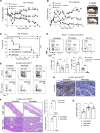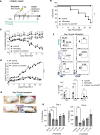Minnelide suppresses GVHD and enhances survival while maintaining GVT responses
- PMID: 38602775
- PMCID: PMC11141936
- DOI: 10.1172/jci.insight.165936
Minnelide suppresses GVHD and enhances survival while maintaining GVT responses
Abstract
Allogeneic hematopoietic stem cell transplantation (aHSCT) can cure patients with otherwise fatal leukemias and lymphomas. However, the benefits of aHSCT are limited by graft-versus-host disease (GVHD). Minnelide, a water-soluble analog of triptolide, has demonstrated potent antiinflammatory and antitumor activity in several preclinical models and has proven both safe and efficacious in clinical trials for advanced gastrointestinal malignancies. Here, we tested the effectiveness of Minnelide in preventing acute GVHD as compared with posttransplant cyclophosphamide (PTCy). Strikingly, we found Minnelide improved survival, weight loss, and clinical scores in an MHC-mismatched model of aHSCT. These benefits were also apparent in minor MHC-matched aHSCT and xenogeneic HSCT models. Minnelide was comparable to PTCy in terms of survival, GVHD clinical score, and colonic length. Notably, in addition to decreased donor T cell infiltration early after aHSCT, several regulatory cell populations, including Tregs, ILC2s, and myeloid-derived stem cells in the colon were increased, which together may account for Minnelide's GVHD suppression after aHSCT. Importantly, Minnelide's GVHD prevention was accompanied by preservation of graft-versus-tumor activity. As Minnelide possesses anti-acute myeloid leukemia (anti-AML) activity and is being applied in clinical trials, together with the present findings, we conclude that this compound might provide a new approach for patients with AML undergoing aHSCT.
Keywords: Cellular immune response; Immunology; Stem cell transplantation; Transplantation.
Figures








Similar articles
-
Early administration of lenalidomide after allogeneic hematopoietic stem cell transplantation suppresses graft-versus-host disease by inhibiting T-cell migration to the gastrointestinal tract.Immun Inflamm Dis. 2022 Sep;10(9):e688. doi: 10.1002/iid3.688. Immun Inflamm Dis. 2022. PMID: 36039651 Free PMC article.
-
Superior immune reconstitution using Treg-expanded donor cells versus PTCy treatment in preclinical HSCT models.JCI Insight. 2018 Oct 18;3(20):e121717. doi: 10.1172/jci.insight.121717. JCI Insight. 2018. PMID: 30333311 Free PMC article.
-
Dual activity of Minnelide chemosensitize basal/triple negative breast cancer stem cells and reprograms immunosuppressive tumor microenvironment.Sci Rep. 2024 Sep 28;14(1):22487. doi: 10.1038/s41598-024-72989-6. Sci Rep. 2024. PMID: 39341857 Free PMC article.
-
Alloreactivity as therapeutic principle in the treatment of hematologic malignancies. Studies of clinical and immunologic aspects of allogeneic hematopoietic cell transplantation with nonmyeloablative conditioning.Dan Med Bull. 2007 May;54(2):112-39. Dan Med Bull. 2007. PMID: 17521527 Review.
-
Defibrotide combined with triple therapy including posttransplant cyclophosphamide, low dose rabbit anti-t-lymphocyte globulin and cyclosporine is effective in prevention of graft versus host disease after allogeneic peripheral blood stem cell transplantation for hematologic malignancies.Transfus Apher Sci. 2022 Feb;61(1):103367. doi: 10.1016/j.transci.2022.103367. Epub 2022 Jan 24. Transfus Apher Sci. 2022. PMID: 35120825 Review.
Cited by
-
Hematopoietic stem cells: Understanding the mechanisms to unleash the therapeutic potential of hematopoietic stem cell transplantation.Stem Cell Res Ther. 2025 Feb 10;16(1):60. doi: 10.1186/s13287-024-04126-z. Stem Cell Res Ther. 2025. PMID: 39924510 Free PMC article. Review.

